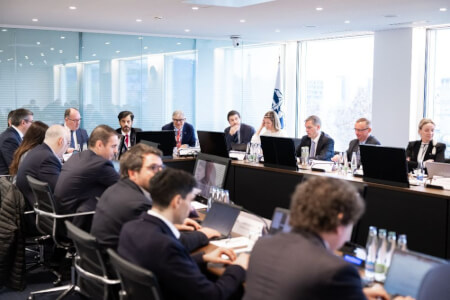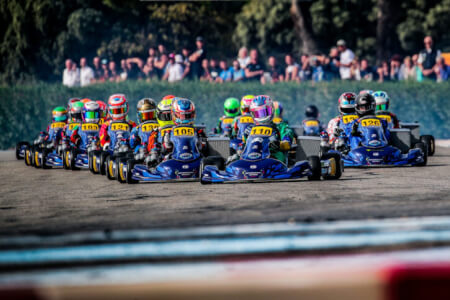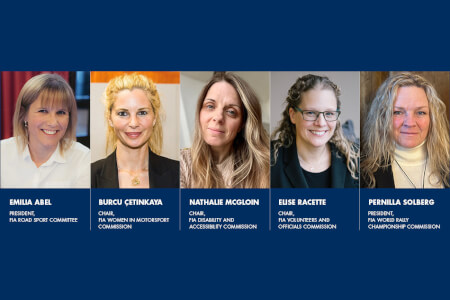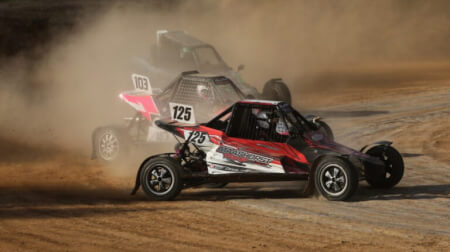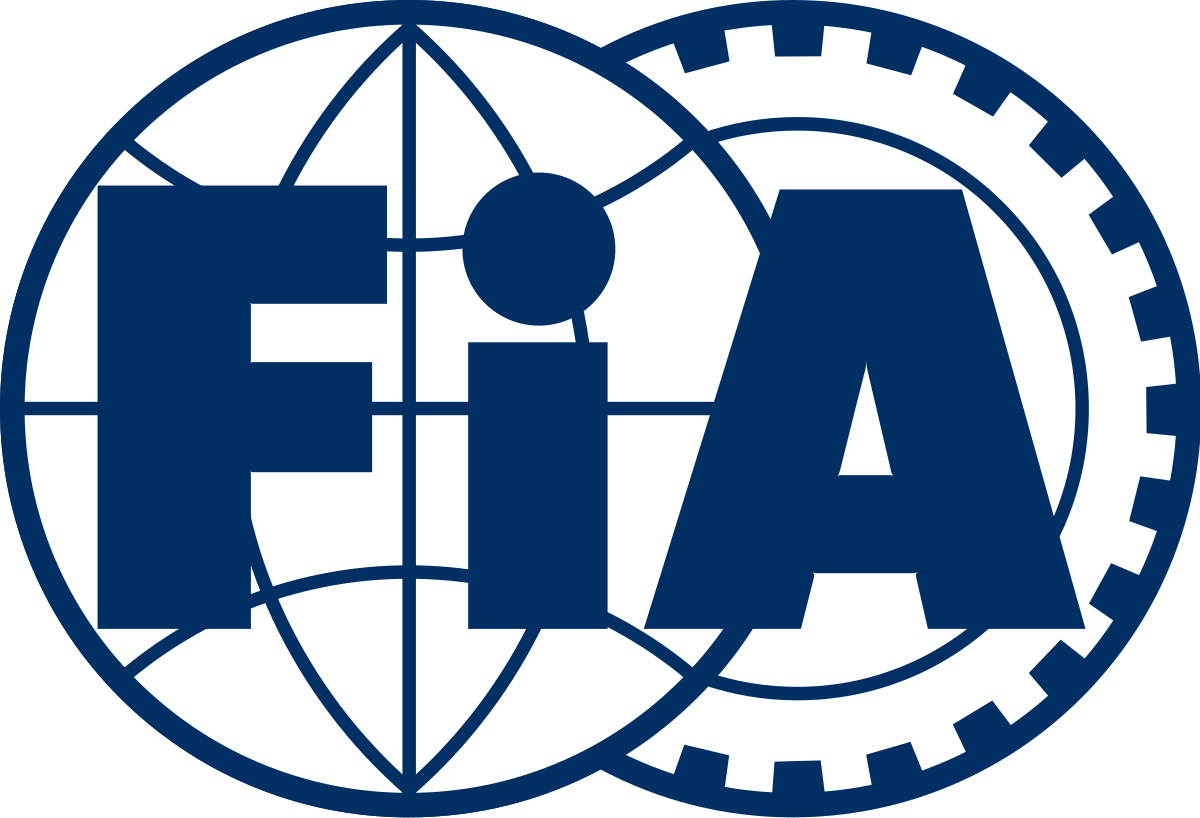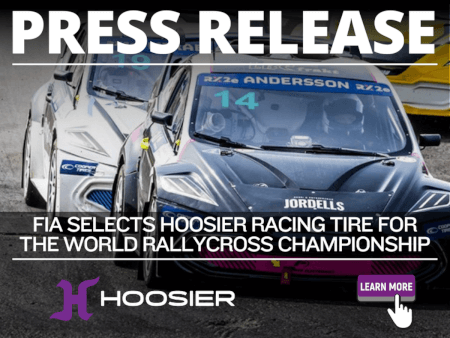February 29th 2024
Technologies and strategies for the future set out at first World Motor Sport Council meeting of 2024
The FIA World Motor Sport Council convened today, 28 February, for its first meeting of 2024. The meeting was chaired by President Mohammed Ben Sulayem with FIA Deputy President for Sport Robert Reid and WMSC members joining in person at the Federation’s offices in Geneva and from around the world via video conference.
In his opening address, the FIA President updated the World Council on new Commission President appointments. He said:
“This gathering is a momentous occasion as we welcome our new Presidents and Chairpersons to a number of Commissions and Committees. I am delighted to say that four of the newcomers are women. The FIA is dedicated to growing the number of women in senior posts within the FIA, and these appointments are an important step in our efforts to achieve this.”
Noting some significant events that have taken place since the previous World Council gathering which took place as part of the General Assembly in Baku, Azerbaijan in December 2023, he added:
“In recent months we have held the MENA and Africa Karting Cup events, a first for the African region. Motor sport that is affordable and accessible for all – that is our goal – and we are indebted to the support of our Member Clubs for the staging of these events.”
In his opening address, the FIA President updated the World Council on new Commission President appointments. He said:
“This gathering is a momentous occasion as we welcome our new Presidents and Chairpersons to a number of Commissions and Committees. I am delighted to say that four of the newcomers are women. The FIA is dedicated to growing the number of women in senior posts within the FIA, and these appointments are an important step in our efforts to achieve this.”
Noting some significant events that have taken place since the previous World Council gathering which took place as part of the General Assembly in Baku, Azerbaijan in December 2023, he added:
“In recent months we have held the MENA and Africa Karting Cup events, a first for the African region. Motor sport that is affordable and accessible for all – that is our goal – and we are indebted to the support of our Member Clubs for the staging of these events.”
Pathway for the future of the FIA World Rally Championship agreed
The roadmap for the future of the FIA World Rally Championship, presented to the World Council over the past two days by the WRC Working Group, has been given the green light. The Working Group has generated a review of the current state of the championship, a record of the sport’s key attributes to be sustained, and the definition of a series of objectives for the future.
Established at the request of FIA President Mohammed Ben Sulayem in December and headed by FIA Deputy President for Sport Robert Reid and WMSC member David Richards, the Working Group, comprising WMSC representatives Garry Connelly, Ronan Morgan and Andrew Mallalieu as well as FIA executives Andrew Wheatley and Xavier Mestelan Pinon, have put forward objectives that prioritise plans for far greater focus on PR, Marketing and Promotion of the Championship, and set a framework for changes to the sporting and technical aspects of the WRC to be developed.
The WRC Commission has now been tasked with drafting concrete proposals, based on the WRC Working Group’s recommendations, for submission to the next WMSC meeting, with the new sporting and technical regulations for the 2025 WRC season and beyond to be published by the end of June.
As well as utilising their extensive expertise and experience, the WRC Commission representatives will also be taking into consideration the results of the WRC Fan Engagement Survey. The survey, which was commissioned by the FIA and received more than 11,000 responses, provided invaluable feedback on several topics, such as the format of rallies, car type and specification.
The roadmap for the future of the FIA World Rally Championship, presented to the World Council over the past two days by the WRC Working Group, has been given the green light. The Working Group has generated a review of the current state of the championship, a record of the sport’s key attributes to be sustained, and the definition of a series of objectives for the future.
Established at the request of FIA President Mohammed Ben Sulayem in December and headed by FIA Deputy President for Sport Robert Reid and WMSC member David Richards, the Working Group, comprising WMSC representatives Garry Connelly, Ronan Morgan and Andrew Mallalieu as well as FIA executives Andrew Wheatley and Xavier Mestelan Pinon, have put forward objectives that prioritise plans for far greater focus on PR, Marketing and Promotion of the Championship, and set a framework for changes to the sporting and technical aspects of the WRC to be developed.
The WRC Commission has now been tasked with drafting concrete proposals, based on the WRC Working Group’s recommendations, for submission to the next WMSC meeting, with the new sporting and technical regulations for the 2025 WRC season and beyond to be published by the end of June.
As well as utilising their extensive expertise and experience, the WRC Commission representatives will also be taking into consideration the results of the WRC Fan Engagement Survey. The survey, which was commissioned by the FIA and received more than 11,000 responses, provided invaluable feedback on several topics, such as the format of rallies, car type and specification.
The key objectives have been set out as follows:
Promotion
Promotion
- In order to leverage promotional opportunities around each event and maximise the WRC’s full potential, the FIA will establish a WRC Promotion Team within the FIA in close collaboration with stakeholders from the WRC Promoter, event organisers and manufacturer teams.
- The WRC Promotion Team’s key focus will be to develop a WRC Charter that will define a set of commitments from all stakeholders to promote the WRC to a wider audience against an agreed set of objectives and KPIs.
- This coordinated approach will leverage the expertise of each party in order to promote the WRC outside its current fan base as one of the foremost motor sport championships in the world.
Sporting
- Event organisers will be given more freedom when developing the route of their rally. However, while the starting day of an event and the number of stage kilometres can vary, all rallies should finish on a Sunday with the Power Stage.
- The global calendar may include a small number of shorter sprint-style and longer endurance events in addition to the rallies that follow the existing format. Nevertheless, the overall timed kilometres covered during a season will remain largely unchanged with events still organised on a mix of asphalt, gravel and snow.
- As part of cost-cutting measures, the target number of personnel of a three-car team will be capped in the future.
- The service park set-up will follow a new model with manufacturers allocated locally sourced structures as a working space. As well as saving costs and reducing the amount of transportation required, the move provides more flexibility, should the service park location change during an event. It also reduces the total area required for the service park by event organisers.
- To allow organisers to adopt less rigid formats, reduce liaison section distances and spread the reach of events, remote service opportunities will be encouraged with teams permitted to carry limited parts in a small support vehicle.
Technical
- The current Rally1 car will continue as the WRC’s flagship vehicle in both 2025 and 2026 but with modifications to reduce cost and performance. These include the removal of the plug-in hybrid unit, with the performance compensated by a reduction in overall weight, and a reduction in the air restrictor and aerodynamics.
- Rally2 cars will continue in their current form for the duration of their homologation as the basis for national and international series. However, Rally2 cars competing on WRC events from 2025 and beyond will have an option to run with a WRC kit consisting of a larger restrictor, a larger exhaust, an optional paddle shift gearbox and a rear wing with the objective of reducing the performance gap between Rally1 and Rally2 cars.
- From 2026, revised Rally1 technical regulations for the WRC’s top-level category will be introduced based on the current Rally1 concept. These regulations will run alongside the current Rally1 regulations for the 2026 season. These new rules will use a common safety cell to reduce costs and complexity, and allow manufacturers and tuners to develop cars with their own bodywork based on production models including B-class, C-Class, compact SUV or a Concept Car designed to tight technical criteria such as centre of gravity and aerodynamics in order to equalize performance.
- The power output will be targeted at 330hp, with the engine performance controlled by a reference torque curve for all cars. Engine and transmission will be cost-capped and technology limited to Rally2 equivalence. Aerodynamic efficiency will be limited along with a top speed restriction to reduce development and cost.
- The cost per car will be capped at €400,000 and WRC manufacturers will be required to make their cars available for sale directly from the finish parc fermé of a WRC event.
- At the earliest opportunity, an electric category will be introduced into the WRC with the FIA technical department charged with establishing suitable technical regulations that could utilise the new Rally1 safety cell and achieve parity of performance with Rally1 cars running on sustainable fuel.
FIA President Mohammed Ben Sulayem said: “The WMSC members carefully considered the recommendations of the WRC Working Group and were united in their support of the series of objectives that have been established. To be at the point where the WRC Commission can now work on finalising proposals that will go a long way towards cementing the WRC’s future course, once approved by the WMSC, is a significant moment for the championship, its stakeholders and the rallying community in general. It’s also important to note that the results of the WRC Fan Engagement Survey will be carefully considered by the WRC Commission during the process of drafting the final proposals. I thank all those who took part as we continue the process of delivering a WRC that’s relevant for the present and fit for the future.”
A new alternative – FIA presents vision for future Hydrogen fuel technologies
As part of the FIA’s energy transition road map, which defines gradual introduction of sustainable power sources in motor sport, the FIA continues development of hydrogen-fuelled power units across different disciplines and competitions.
As the next phase, the FIA will focus its efforts on contribution to development and promotion of solutions based on hydrogen stored in liquid form (LH2). Given the tank’s characteristics, lower volume and weight compared to compressed gas tanks (CGH2), liquid storage form is better suited to the demanding environment of motor sport competitions, where optimisation is key. This also allows the powertrain layout to remain closer to the one of a conventional combustion-powered car compared with vehicles accommodating compressed gas tanks.
Solutions utilising compressed gas storage type will be considered as interim solution, provided minimum safety and technical requirements are met.
The FIA has been leading the work on regulations for hydrogen-powered vehicles in motor sport, with safety being one of the key considerations, since 2019, when it formed its FIA Hydrogen Technical Working Group, gathering numerous manufacturers and industry-leading companies.
In 2020, the FIA World Motor Sport Council approved the addition of article 253.19 (which outlines safety regulations for hydrogen-powered vehicles in motor sport) to its International Sporting Code.
As part of the FIA’s energy transition road map, which defines gradual introduction of sustainable power sources in motor sport, the FIA continues development of hydrogen-fuelled power units across different disciplines and competitions.
As the next phase, the FIA will focus its efforts on contribution to development and promotion of solutions based on hydrogen stored in liquid form (LH2). Given the tank’s characteristics, lower volume and weight compared to compressed gas tanks (CGH2), liquid storage form is better suited to the demanding environment of motor sport competitions, where optimisation is key. This also allows the powertrain layout to remain closer to the one of a conventional combustion-powered car compared with vehicles accommodating compressed gas tanks.
Solutions utilising compressed gas storage type will be considered as interim solution, provided minimum safety and technical requirements are met.
The FIA has been leading the work on regulations for hydrogen-powered vehicles in motor sport, with safety being one of the key considerations, since 2019, when it formed its FIA Hydrogen Technical Working Group, gathering numerous manufacturers and industry-leading companies.
In 2020, the FIA World Motor Sport Council approved the addition of article 253.19 (which outlines safety regulations for hydrogen-powered vehicles in motor sport) to its International Sporting Code.
